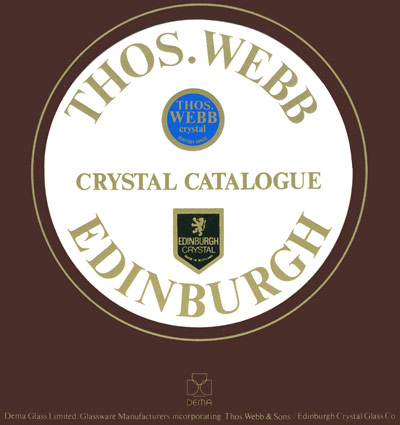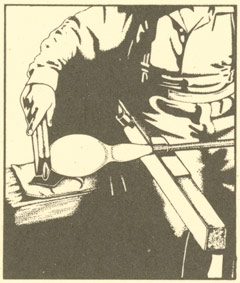The Tradition of
Thos. Webb Crystal
Expert Craftsmen
Glassmaking was introduced into the Stourbridge district at the beginning of the 17th century by members of old-established glassmaking families - notably those of Henzey, Tyzack and Tyttery - who had come to England from France in the previous century. Usually they had at first established their glassworks in rural areas where there was an ample supply of timber for fuelling their furnaces, but the government of the day was becoming increasingly concerned about the quantity of wood that was being burned in the furnaces and eventually the glassmakers were prohibited from consuming any more - so they had to resort to burning coal.
The attraction of the Stourbridge area was the presence of excellent fireclay, suitable for making the crucibles in which glass could be melted, and an ample supply of coal, much of it near the surface. Within a short time, these distinguished glassmakers were joined by others from Italy, bearing such names as Visitellia and Racket.
In the second half of the 19th century there was another influx of foreign glass craftsmen, but this time most of them were engravers rather than glassblowers. The most distinguished of these were employed at the Dennis Glassworks of Thomas Webb and Sons. Chief of these newcomers were Bohemians -Frederick Engelbert Kny, William Fritsche and Joseph Palme - who had been reared in their country’s great traditions as engravers, but there was also a Frenchman named Jules Barbe who was an expert in applying enamelled and gilded decoration to glass.
It was after seeing some of the work of Barbe at the 1878 Paris Exhibition, that Thomas Wilkes Webb invited him to come to Stourbridge to employ his remarkable technique. In the 1880’s he was much engaged in painting in enamels on the “Queen’s Burmese” glass which Thomas Webb and Sons were making under licence from the Mount Washington Glass Co. of New Bedford, Massachusetts.
F. E. Kny came to Amblecote in the 1860’s and was provided with his own workshop at the Dennis Glassworks where he was occupied with engraving and intaglio. The words “rock crystal” first appeared in Thomas Webb’s pattern book in 1879 relating to a table set engraved with animal scenes by Kny. One of his finest works was a crystal glass claret jug engraved with a frieze of Greek horsemen. Known as the Elgin Jug, it was completed in 1873.
The Elgin Jug
Shown in The Glass Catalogue here
Engraved by Frederick Engelbert Kny. Exhibited at the Paris International Exhibition, 1878.
Claret Jug
Shown in The Glass Catalogue here
Richly engraved. Exhibited at the Paris International Exhibition, 1878.
William Fritsche was also engaged in the production of rock crystal, which owed its name to the effect obtained by polishing engraved and intaglio decoration, and he has been credited with the introduction of this type of decoration at Dennis. Webbs exhibited their first examples of rock crystal at the 1878 Paris Exhibition. In some of Fritsche’s work the engraving is so deep that it might well be termed glass sculpture. Probably his most famous piece is the Fritsche Ewer which represents the sea, the ornament including a mask of Neptune under the lip, waves and fish on the body and shells on the foot. This is now in an American museum. At the 1878 Paris Exhibition Fritsche had on show a fine pair of vases engraved with peacocks; vases of this type were then offered for sale at £45 a pair. Franz Joseph Palme joined Webbs in 1882 and specialised in engraving animals. Like Fritsche and Kny, he signed much of his work.
Masterpiece In Glass
Among the master craftsmen-artists who carved cameo glass for Thomas Webb and Sons at Amblecote, were the brothers Thomas and George Woodall. Specimens of their work have been eagerly sought by collectors. A vase entitled “Aurora”, depicting the goddess floating among clouds, signed “Geo. Woodall”, was sold at Sotheby’s, London, in June 1974 for £5,200. A similar style of vase known as “Mischief”, depicting a draped young woman seated on a rock with a cupid whispering in her ear, signed by George Woodall, was sold in July 1975 for £5,800.
The Polar Vase
Shown in The Glass Catalogue here
Designed by Lionel Pearce, was inspired by Shackleton’s expedition to the North Pole. Made at the Dennis Glassworks, it was shown at the Franco-British Exhibition, 1908.
The Rose
Shown in The Glass Catalogue here
A 16-in. cameo glass vase made at the Dennis Glassworks, c. 1895, and carved by George Woodall.
For Collectors
Two of the handsome commemorative glass articles produced in limited editions by Thomas Webb and Sons at the Dennis Glassworks.
Goblet for the Investiture of the Prince of Wales, 1969. Shown in The Glass Catalogue here
Goblet for the Silver Wedding of H.M. The Queen and H.R.H. Prince Philip, 1972. Shown in The Glass Catalogue here
|















